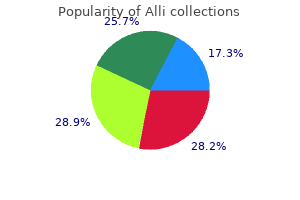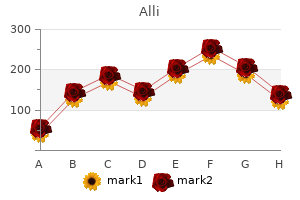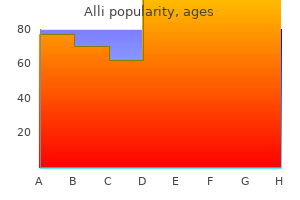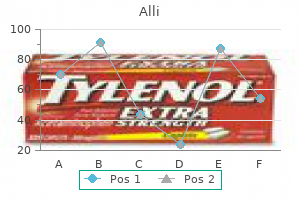"60mg alli free shipping, weight loss pills gmc".
By: X. Osko, MD
Associate Professor, Indiana Wesleyan University
Similar to the pattern for women weight loss pills fda approved buy alli 60mg with mastercard, the three modes of transmission most often mentioned by men were blood transfusions (82 percent) weight loss pills research generic 60 mg alli with amex, other contact with the blood of an infected person (67 percent) weight loss for women over 50 cheap 60mg alli mastercard, and use of unclean needles (52 percent) weight loss meds cheap alli 60mg on line. Both sexual relations and mother-to-child transmission are common ways of contracting hepatitis B. Around onequarter of women and one-fifth men believed incorrectly that hepatitis B can be transmitted through casual physical contact. Two percent of women and 6 percent of men age 15-59 had ever been tested for hepatitis B, and 6 percent of women and 18 percent of men had ever been tested for hepatitis C. Only a small proportion of adults or children had ever been diagnosed as having any form of hepatitis or other liver disease (4 percent and 2 percent, respectively). Adults most often reported having been told they had hepatitis C (1 percent of women and 4 percent of men), while children had most often been diagnosed Knowledge and Prevalence of Hepatitis B and C נ35 as having hepatitis A (1 percent of girls and 2 percent of boys). Ten percent of adults and 4 percent of children had experienced common symptoms of liver disease, most often dark urine (9 percent of adults and 4 percent of children). Only 2 percent of adults reported they currently had hepatitis C, and only a very few adults (0. No children were reported as having been diagnosed with a current hepatitis B or C infection. The number of children reported as having had hepatitis B and C and the number of adults reported as having had hepatitis B were too small to provide reliable data on treatment status. The drugs that ever-infected adults reported most often receiving were interferon (33 percent) and Legalon (18 percent). Only 2 percent of everinfected adults reported that they received Sovaldi as a treatment. This is not surprising since Sovaldi has only very recently become available to treat hepatitis C. The component involved the collection of venous blood samples from all individuals for whom informed consent was obtained during the survey. The results of the hepatitis tests were returned to individuals in a separate field operation following the completion of the laboratory testing. The following sections describe the coverage of hepatitis testing and the outcome of the operation to return results of the testing. The difference in the coverage rates for females and males was minimal, with 95 percent of females and 94 percent of males providing a blood sample for testing. The rate exceeded 95 percent in all other age groups except children age 5-14 and adults age 50-59. Testing coverage was slightly higher in rural areas (97 percent) than in urban areas (92 percent). By place of residence, the proportion with a sample tested was highest in rural Lower Egypt (98 percent) and lowest in urban Upper Egypt and urban Lower Egypt (91 percent). Coverage levels were 90 percent or higher in all governorates except Giza, where hepatitis tests were conducted for 88 percent of interviewed respondents (data not shown in table). Among adults age 15-59, there was little variation in coverage rates by educational level. At the time the results were returned, respondents who were found to be positive on the hepatitis B or hepatitis C tests were referred to special national liver centers or other health facilities for counseling and treatment, if needed. These antibodies are produced by the body at the time of the first exposure to the hepatitis B virus to fight the infection. A positive result on the Chemiluminescence test indicated that an individual had ever been infected with the hepatitis C virus. The proportion testing positive on the core antibody test increases sharply with age, from less than 1 percent among children age 1-14 to a peak of 43 percent among respondents age 55-59. Overall, only 1 percent of individuals age 1-59 or nearly 800,000 persons1, had an active hepatitis B infection. The percentage of individuals with an active hepatitis B infection was very low among those under age 20 (0. The rapid expansion of the coverage of hepatitis B vaccinations following their addition to the national immunization program in the 1990s likely means that the low hepatitis B infection rates observed among children and young adults will be the norm among older cohorts as well in the future. The proportion found to have an active hepatitis C infection varied from less than 1 percent among individuals under age 20 to 22 percent among those age 55-59.


Fumes given off by other heat processes including smelting should be coded under the appropriate metal compound weight loss pills drug store buy alli once a day, if known weight loss 2 months alli 60 mg fast delivery. Other weight loss 30 day shred buy alli overnight delivery, not elsewhere classified Chapter D ͠Source weight loss pills miranda lambert best purchase for alli, Target, and Other Equipment D-10 Excludes: 0501 0502 0504 0507 0508 0511 0512 0514 0515 0521 0599 Unspecified 06 Agricultural chemicals and other pesticides this group includes such substances as insecticides, pesticides, herbicides, fumigants, rodenticides, and fungicides. These substances should be coded in this group whether used in the agricultural and horticultural industries, by commercial exterminating and pest control companies or by companies in other industries. This category should be used only when the specific chemical is unknown or is not classifiable elsewhere. Includes: Adhesives, alcoholic beverages, beauty products, cleaning agents, cosmetics, drugs, explosives, glues, medicines, paints, lacquers, varnishes, solvents, degreasers, dyes, inks, tear gas, mace, and photographic and copying solutions. Includes: Excludes: Coal, coal dust, coke, crude oil, gasoline, natural gas, petroleum, petroleum distillates and fuels. Agricultural chemicals and other pesticides (06); paints (0713); petroleum solvents (0716); asphalt, roofing tar (47). Includes: Ammonia and ammonium compounds, carbon dioxide, carbon monoxide, cryogenic gases, cyanide and cyanide compounds, dry ice, methane, mine gas, oxygen and oxygen compounds, plastics, resins, sewer gas, sulfur, sulfur compounds, sulfur dioxide. Pressurized and nonpressurized containers are fix-shaped receptacles used to hold, store, or carry materials. Variable restraint containers include bundles, packages, and rolls where the material being contained is usually the surface of the container. Includes: Excludes: Pressurized containers; nonpressurized containers; variable restraint containers; dishes, cups, glasses; luggage; skids and pallets. Cases, cabinets, racks, shelves (22); bathtubs (2501); coffee makers (3404); septic tanks (6199); hot tubs (6424); sleeping bags, back packs, portable coolers, and thermoses (7999). Includes: Bags, sacks, totes, barrels, kegs, drums, ottles, jugs, flasks, boxes, crates, cartons, buckets, baskets, pails, cans, pots, pans, trays, tanks, bins, and vats. Pressurized containers (13); variable restraint containers (14); dishes, drinking cups, and beverage glasses (15); luggage (16); skids and pallets (17); groceries (5301); laundry (9299). Air and gas compressors (3901); pressure-cooking equipment (3499); pipes, ducts, tubing (42); valves (4319). Bottles (1205); pitchers (1299); pots, pans, trays (1219); cooking and eating utensils (7199). Includes: Excludes: 1601 Briefcases, handbags, pocketbooks, wallets, and suitcases. The furniture and fixtures classified here may be of any composition, and may be Chapter D ͠Source, Target, and Other Equipment D-20 designed for use in households, businesses, or public buildings. Includes: Excludes: Cases; cabinets; racks; shelves; floor, wall, and window coverings; furniture; other fixtures. Heating, cooling, and cleaning machinery and appliances (34), audio and video equipment (39), car seats (4999), plumbing systems (6199), structures (64), pianos (7199). Includes: Excludes: 2201 Bookcases; display and storage cabinets, cases; counters, counter tops; garment and other racks; lockers; partitions; shelving. Includes: Excludes: Floor coverings; wall coverings; window coverings, blinds, shades, or draperies. Rolls of carpet or linoleum (1404); ceiling tiles (4225); vinyl floor tiles (4225); wood paneling (4299); sheet flooring (4299); siding (4222); wallboard (4299). Includes: Excludes: Beds, bedding, mattresses, benches, workbenches, saw horses, chairs, desks, sofas, tables, and worktables. Cases, cabinets, racks, shelves (22); lamps (2503); air mattresses, sleeping bags, billiard and ping pong tables (7999); pianos (7199); sheets, linens (9299). Electrical parts (45), wiring (4561), plumbing system (6199), flashlights (7399), flash bulbs (7799), lanterns (7999), pipes (4214), valves (4319). Machinery is defined as a combination of smaller machines (elements or parts) which are capable of motion and are contained in a stationary frame. Computer, audio, and video products, as well as heating, cooling and cleaning machinery and appliances are also included in this definition. Machines which are primarily used for transporting people or materials are classified in division 8. If a part of known or assumed to be attached to the machine when an injury occurs, then the entire machine should be listed as the source in this division.

For example weight loss pills before and after order alli in united states online, healthy coastal wetlands may provide a wide range of services to individuals who live near them (such as filtering pollutants present in water) weight loss pills jennifer hudson purchase alli 60 mg line. A replacement cost approach would estimate the value of these services by estimating market costs for replacing the services provided by the wetlands weight loss orlando purchase alli 60 mg with amex. Analogously weight loss pills lipo 6 buy cheap alli 60 mg line, the cost of health effects can be estimated using the cost of treating illness and of the lost workdays, etc. This approach calculated value based on the contribution of an input into some productive process. This approach can be used to determine the value of both market and non-market inputs, for example, fertilizer, water, or soil, in farm output and profits In the remainder of this section, we briefly discuss the relationship between climate change and four non-market effects (human health, ecosystems, recreation and tourism, and amenities), and discuss economic estimates of these effects using these techniques. In addition to changes in mortality and morbidity, climate change may affect health in more subtle ways. Good health is more than the absence of illness; it includes mental health, the ability to function physically (to climb stairs or walk a mile), socially (to move freely in the world), and in a work environment. Please see Chapter 2 of this report, which provides an overview of health effects that have been associated with climate change. Even where our understanding of underlying climate and health relationships is better, few studies have attempted to explicitly link these findings to climate change scenarios to quantitatively estimate health impacts. Economists have relatively well established (although sometimes controversial) techniques for valuing mortality and some forms of morbidity, which could, in theory be applied to quantified impacts assessments. It has a well-developed health infrastructure and government and non-governmental agencies involved in disaster planning and response, both of which can help to mitigate potential health effects from climate change. This, coupled with an aging (and therefore more vulnerable) population, will increase the likelihood of higher mortality from exposure to excessive heat (see, for example, Semenza et al. Climate change is projected to alter the frequency, timing, intensity, and duration of extreme weather events, such as hurricanes and floods (Fowler and Hennessey, 1995). The health effects of these extreme weather events range from the direct effects, such as loss of life and acute trauma, to indirect effects, such as loss of shelter, large-scale population displacement, damage to sanitation infrastructure (drinking water and sewage systems), interruption of food production, damage to the health care infrastructure, and psychological problems such as post traumatic stress disorder (Curriero et al. Climate change can affect air quality by modifying local weather patterns and pollutant concentrations (such as ground level ozone), by affecting natural sources of air pollution, and by changing the distribution of airborne allergens (Morris et al. Many of these effects are localized and, for ozone, compounded by assumptions of trends in precursor emissions. Despite these uncertainties, all else being equal, climate change is projected to contribute to or exacerbate ozone-related illnesses. Altered weather patterns, including changes in precipitation, temperature, humidity, and water salinity, are likely to affect the distribution and prevalence of food- and waterborne diseases resulting from bacteria, overloaded drinking water systems, and increases in the frequency and range of harmful algal blooms (Weniger et al. Moderating factors, such as housing quality, land-use patterns, vector control programs, and a robust public health infrastructure, are likely to prevent the large-scale spread of these diseases in the United States. As described in Chapter 2, there is considerable speculation concerning the balance of climate change-related decreases in winter mortality compared with increases in summer mortality, although researchers suspect that declines in winter mortality associated with climate change are unlikely to outweigh increases in summer mortality (McMichael et al. Using average temperatures to estimate cold-related mortality, for example, is complicated by the fact that many factors contribute to winter mortality (such as spread of the influenza virus). Similarly, increased summer mortality may be affected not only by average temperature, but also by other temperature factors, such as variability in temperature, or the duration of heat waves. Moreover, quantifying projected temperature-related mortality requires going beyond epidemiology and (for example) projecting adaptive behaviors, such as the use of air conditioning, expanded public programs (such as heat warning systems), or migratory patterns. Few studies have attempted to link the epidemiological findings to climate scenarios for the United States, and studies that have done so have focused on the effects of changes in average temperature, with results dependent on climate scenarios and assumptions of future adaptation. Below, we report the results of these studies in order to give a sense of the magnitude of mortality that might be associated with temperature changes associated with climate change and, by intimation, the magnitude of potential changes in economic welfare. The conclusions should be considered preliminary, however, in part because of the complexities in estimating mortality under future climate scenarios. Moreover, none of the studies reported below traces through the quantitative implications of various climate scenarios for mortality in all regions of the United States using region-specific data, suggesting a clear need for future research. The exposure-response function can be used to compute the relative risk of illness or death due to a specified change in climate. Applying this relative risk to the baseline incidence of the illness or death in a population yields an estimated number of cases associated with the climate scenario. Two studies have attempted to link exposure-response functions to future climate scenarios and thereby develop temperature-related mortality estimates. No adjustment is made for attempts to mitigate the effects of higher temperatures through (for example) increased use of air-conditioning. From a baseline of 165 excess deaths in the 1990s, heat-related deaths in Los Angeles are projected to increase two to three times under scenario B1 and five to seven times under scenario A1fi by 2090.

Syndromes
- Brain or central nervous system disorders
- Sweating
- The labia may be fused and look like a scrotum.
- Name of the product (ingredients and strengths, if known)
- Injuries to the surrounding tissues generally take 3 - 6 weeks to heal. Sometimes, surgery to repair a torn ligament is needed.
- Factitious hyperthyroidism
- Skin lesions
- Thyroid hormone replacement pills, if the goiter is due to an underactive thyroid
- Arthritis
Similarly weight loss pills ketone generic 60 mg alli otc, the "waste not" rule can also lead consumers to forego options that they predict more enjoyable and choose the less enjoyable one weight loss lipozene buy cheap alli 60mg on-line. Arkes and Blumer (1985) asked participants to imagine that they had purchased a $100 ticket for a weekend ski trip to Michigan and a $50 ticket for a weekend ski trip to Wisconsin weight loss journey blog buy alli online now. They later found out that the two trips were for the same weekend and had to pick one to use weight loss 40days40pounds generic alli 60 mg fast delivery. Although the participants were told that the trip to Wisconsin was more enjoyable, the majority of them chose the more expensive trip to Michigan. Lay Rationalism Besides the specific rules we discussed above, consumers have a general tendency to resist immediate affective influence and base their choice on factors they consider "rational". One is lay economism-the tendency to base decision on the financial aspects of the options and ignore other happiness-relevant factors. In one set, the dinners increased in value (original price) over the 4-week period and the total value was relatively lower. In the other set, the dinners decreased in value over the period and the total value was relatively higher. Participants predicted greater enjoyment from consuming the temporally-increasing set of dinners, yet they chose the set with the greater value in total. Another manifestation of lay rationalism is lay scientism, a tendency to base decision on "hard" (objective and quantitative) attributes rather than "soft" (subjective and hard-to-quantify) attributes. For half of the participants, power was described as an objective wattage rating and sound richness as a subjective experience. For the other half, power was described as a subjective experience and sound richness as an objective quantitative rating. When power was framed as objective, more participants chose the more-powerful stereo than they predicted they would enjoy it more. When sound richness was framed as objective, more participants chose the richer-sounding stereo than they predicted they would enjoy it more. In other words, the objectivity/subjectivity manipulation had a greater influence on choice than on predicted experience. This finding corroborates the notion that consumers base their choice not purely on predicted experience, but also on what they consider "rational," in this case, objective. Impulsivity We define an impulsive choice as choosing an option that yields a better short-term (immediate) experience over an option that yields a better long-term (immediate plus future) experience. For example, eating fatty food may produce better short-term enjoyment than eating healthy food, but it may cause obesity and other health-related problems in the long run. Thus, eating fatty food rather than healthy food can be considered an impulsive choice. For example, some people eat fatty foods, because they underpredict the negative consequences in the future. But more often than not, consumers commit impulsive behavior even though they are keenly aware of its aversive consequence, and they simply cannot resist the temptation. For example, many substance abusers are fully aware that drugs are ruining their lives and may even warn their friends to stay away from drugs, but they cannot resist the craving. In other words, impulsive choosers fail to base their choice on what they predict will bring them the best overall experience. However, we want to suggest a relationship between impulsive behavior and rule-based decisions. So far we have reviewed impulsivity and rules-based-decisions as two unrelated topics. For example, consumers adopting the "waste not" rule may consciously or unconsciously want to preserve their savings so as not to suffer financially in the long run. In some cases, not wasting now can indeed serve that purpose and sometimes it cannot. The problem is that most consumers do not sufficiently distinguish these two types of cases and act too impulsively in the first case but overly apply the rule in the second. For example, consider a college student who plans to travel in Europe for one week. She thought traveling by air is more fun, so she paid $1,000 for a one-week air pass.
60 mg alli otc. 310 NUTRITION | GETTING STARTED | BEST THING FOR WEIGHT LOSS 🤔.


